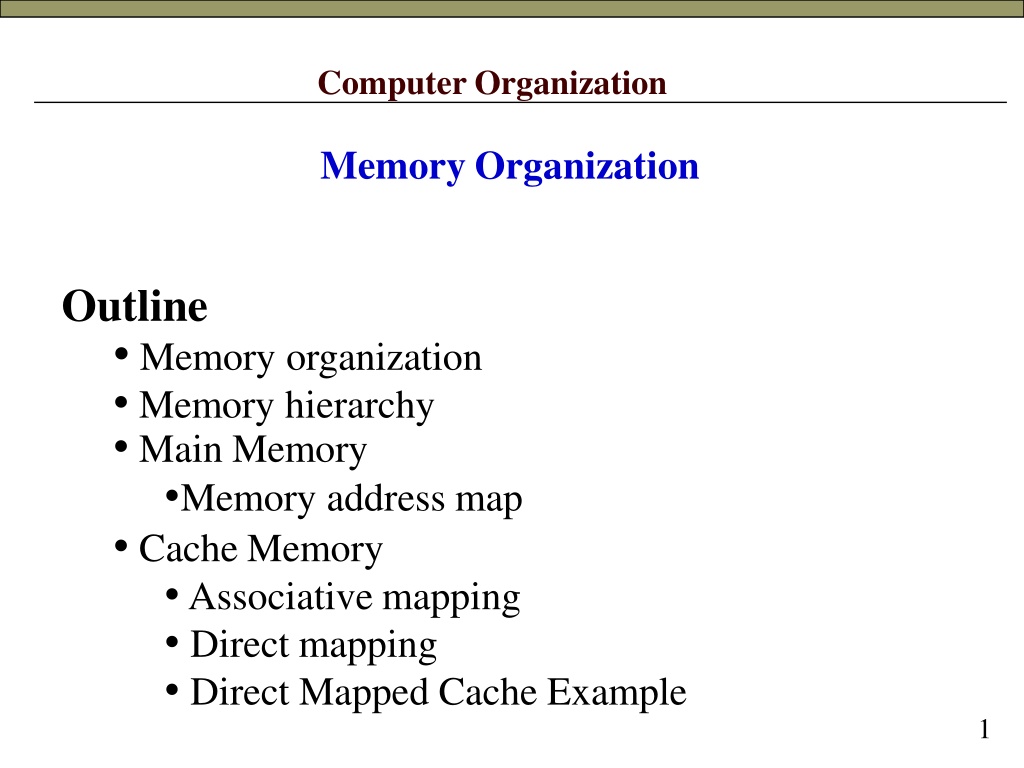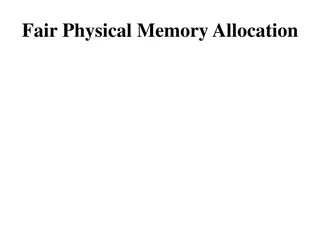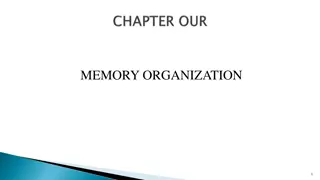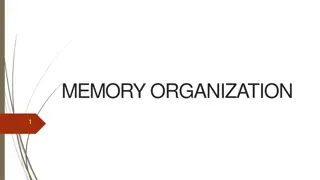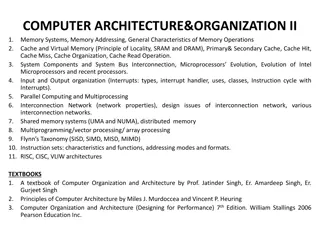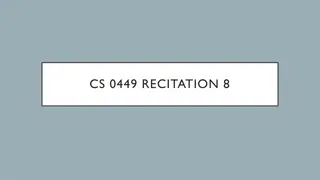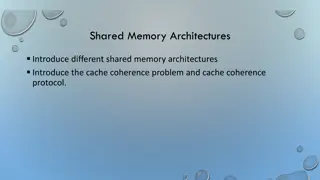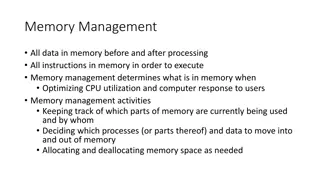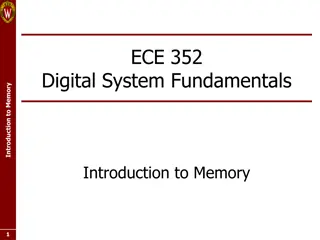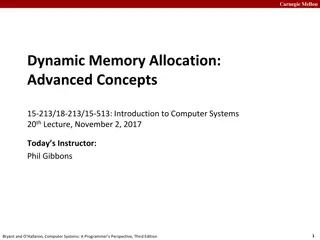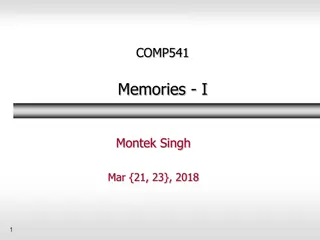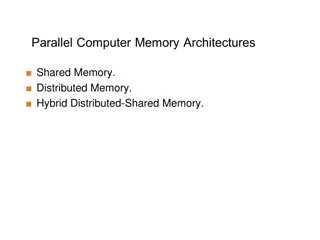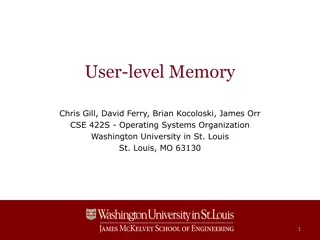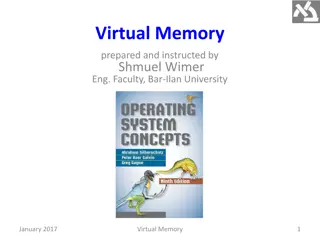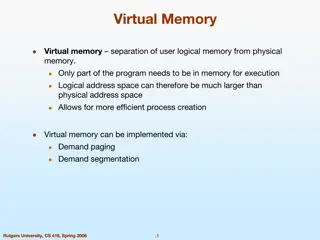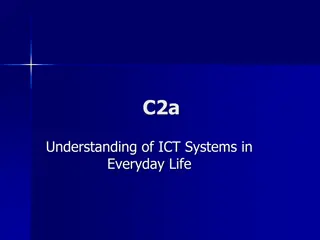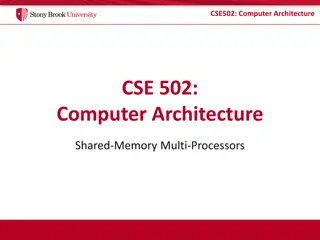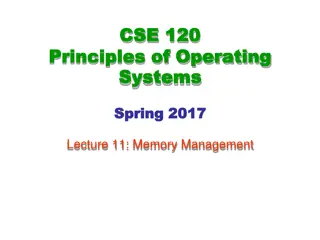Memory Organization in Computer Systems
Information stored in computer memory is in the form of bits grouped into bytes and words. Memory is accessed using addresses with byte-addressable memory being common. Different memory organizations and address mappings play a key role in managing data efficiently. Explore the basics of memory organization, word lengths, byte grouping, memory addressing, and more to understand how data is stored and retrieved in computer systems.
Download Presentation

Please find below an Image/Link to download the presentation.
The content on the website is provided AS IS for your information and personal use only. It may not be sold, licensed, or shared on other websites without obtaining consent from the author.If you encounter any issues during the download, it is possible that the publisher has removed the file from their server.
You are allowed to download the files provided on this website for personal or commercial use, subject to the condition that they are used lawfully. All files are the property of their respective owners.
The content on the website is provided AS IS for your information and personal use only. It may not be sold, licensed, or shared on other websites without obtaining consent from the author.
E N D
Presentation Transcript
Computer Organization Memory Organization Outline Memory organization Memory hierarchy Main Memory Memory address map Cache Memory Associative mapping Direct mapping Direct Mapped Cache Example 1
Memory Organization (1/6) Recall: Information is stored in the memory as a collection of bits. Collection of bits are stored or retrieved simultaneously is called a word. Number of bits in a word is called word length. Word length can be 16 to 64 bits. Another collection which is more basic than a word: Collection of 8 bits known as a byte Bytes are grouped into words, word length can also be expressed as a number of bytes instead of the number of bits: Word length of 16 bits, is equivalent to word length of 2 bytes. Words may be 2 bytes (older architectures), 4 bytes (current architectures), or 8+ bytes (modern architectures). 2
Memory Organization (2/6) Accessing the memory to obtain information requires specifying the address of the memory location. Recall that a memory has a sequence of bits: Assigning addresses to each bit is impractical and unnecessary. Typically, addresses are assigned to a single byte. Byte addressable memory Suppose k bits are used to hold the address of a memory location: Size of the memory in bytes is given by: 2^k where k is the number of bits used to hold a memory address. E.g., for a 16-bit address, size of the memory is 2^16= 65536 bytes What is the size of the memory for a 24-bit address? 3
Memory Organization (3/6) Byte0 Memory is viewed as a sequence of bytes. Address of the first byte is 0 Address of the last byte is 2k 1. Where k is the number of bits used to hold memory address. E.g. when k = 16, Address of the first byte is 0 Address of the last byte is 65535 Byte 2k-1 4
Memory Organization (4/6) Consider a memory organization: 16-bit memory addresses Size of the memory is = 2^16 =65536 B [Byte 0..Byte 65535] Word length is 4 bytes Byte 0 Byte 1 Byte 2 Byte 3 Byte 4 Word #0 Word #1 Number of words = Memory size(bytes) = ? Word length(bytes) =16384 words Word #0 starts at Byte #0. Word #1 starts at Byte #4. Byte 65532 Byte 65533 Byte 65534 Byte 65535 Word #? Last word (Word #?) starts at Byte#? 5
Memory Organization (5/6) Byte 0 Byte 1 Byte 2 Byte 3 Byte 4 Word #0 MAR MDR Word #1 MAR register contains the address of the memorylocation addressed Byte 65532 Byte 65533 Byte 65534 Byte 65535 Word #16383 Addr65532 MDR contains either the data to be written to that address or read from that address. 6
Memory Organization (6/6) Memory read or load: Place address of the memory location to be read from, into MAR. Issue a Memory_read command to the memory. Data read from the memory is placed into MDR automatically (by control logic). Memory write or store: Place address of the memory location to be written to into MAR. Place data to be written into MDR. Issue Memory_write command to the memory. Data in MDR is written to the memory automatically (by control logic). 7
Memory Hierarchy (1/3) The memory unit is then an essential component in any digital computer since it is needed for storing programs and data. The memory unit that communicates directly with the CPU is called the main memory. Devices that provide backup storage are called auxiliary memory (Magnetic disks and tapes). Only programs and data currently needed by the processor reside in main memory. There is a special very thigh speed memory called cache employed between the CPU & main memory to compensate for the mismatch in operating speeds. 8
Memory Hierarchy (2/3) Cache memory is sometimes used to increase the speed of processing by making current programs and data available to the CPU at a rapid rate (extremely fast), Whose access time is close to processor logic clock cycle time. It used for storing segments of programs currently being executed in the CPU and temporary data frequently needed. The cache organization is then concerned with the transfer of information between a main memory and CPU. The part of the computer system that supervises the flow of information between auxiliary memory and main memory is called the memory management system. 9
Memory Hierarchy (3/3) Memory hierarchy in a computer system Auxiliary memory (Secondary) Magnetic tapes Main memory I/O Processor Magnetic disks Cache memory CPU 10
Main Memory (1/4) The main 2 types of main memory are: RAM which is to used to refer to a read/write random-access memory ROM which is to used to refer to a read only random-access memory. Integrated circuit RAM chips are available in two possible operating modes, static and dynamic . The static RAM consists essentially of internal flip flops that store the binary information, the stored information remains valid as long as power is applied to the unit. The dynamic RAM stores the binary information in the form of electric charges that are applied to capacitors. 11
Main Memory (2/4) The stored charge on the capacitors tend to discharge with time and the capacitors must be periodically recharged by refreshing the dynamic memory. The dynamic RAM offers reduced power consumption and larger storage capacity in single memory chip. But the static RAM is easier to use and has shorter read and write cycles. ROM is used for storing programs that are permanently resident in the computer. The ROM portion of main memory is needed for storing an initial program called a bootstrap loader. The bootstrap loader is a program whose function is the start the computer software operating when power is turned on. 12
Main Memory (3/4) RAM and ROM chips are available in a variety of sizes. For example of a 1024 x 8 memory can be constructed with 128 x 8 RAM chips and 512 x 8 ROM chips. CS1 Chip select 1 Chip select 2 Read Write 7-bit address 8-bit data bus CS2 RD 128X8 WR RAM AD7 Memory function Stateof data bus CS1 CS2 RD WR 0 0 1 1 1 1 0 1 0 0 0 1 x x 0 0 1 x x x 0 1 x x Inhibit Inhibit Inhibit Write Read Inhibit High-impedance High-impedance High-impedance Inputdatato RAM Outputdatafrom RAM High-impedance 13
Main Memory (4/4) CS1 CS2 Chip select 1 Chip select 2 8-bit data bus 512X8 ROM 9-bit address AD9 CS1 CS2 Memoryfunction Stateof data bus 0 0 1 1 0 1 0 1 Inhibit Inhibit Read Inhibit High-impedance High-impedance Outputdatafrom ROM High-impedance The data bus can only be in an output mode. When chip is enabled by the 2 select inputs, the byte selected by the address lines appears on the data bus 14
Main Memory: Memory address map (1/4) Memory address map The addressing of memory can be established by means of a table , called a memory address map, that specifies the memory address assigned to each chip. For example, assume that a computer system needs 512 bytes of RAM and 512 bytes of ROM. The memory address map for this configuration is shown in table following table. 15
Main Memory: Memory address map (2/4) MemoryAddress Map for Microprocomputer Addressbus 8 7 6 5 10 9 4 3 2 1 Component Hexadecimaladdress RAM 1 RAM 2 RAM 3 RAM 4 ROM 0000-007F 0080-00FF 0100-017F 0180-01FF 0200-03FF 0 0 0 0 1 0 0 1 1 X X X X X 0 X X X 1 X X X 0 X X X 1 X X X X X X X X X X X X X X X X X X X X X X X 16
Main Memory: Memory address map (3/4) Although there are 16 lines in the address bus, the table shows only 10 lines because the other 6 are not used in this example and are assumed to be zero. The small x's under the address bus lines designate those lines that must be connected to the address inputs in each chip. The RAM chips have 128 bytes and need 7 address lines. The ROM chip has 512 bytes and needs 9 address lines. The x's are always assigned to the low order bus lines: lines 1 through 7 for the RAM and lines 1 through 9 for the ROM. The distinction between a RAM and ROM address is done with another bus line. This can be done by choosing line 10 for this purpose. 17
Main Memory : Memory address map (4/4) Memory address map & Connection to CPU CPU 7 -1 16 11 10 9 8 RD WR Data bus CS1 CS2 RD 128X8 WR AM 1 AD7 Decoder 3 2 1 0 CS1 CS2 RD 128X8 WR RAM 2 AD7 CS1 CS2 RD 128X8 WR RAM 3 AD7 Dat a CS1 CS2 RD 128X8 WR RAM 4 AD7 CS1 CS2 512X8 ROM AD9 18
Cache Memory (1/5) Analysis of a large number of typical programs has shown that the references to memory at any given interval of time tent to be confined within a few localized areas in memory. This phenomenon is known as the property of locality of reference. If the active portions of the program and data are placed in a fast small memory, the average memory access time can be reduced, thus reducing the total execution time of the program. 19
Cache Memory (2/5) The performance of cache memory is frequently measured in terms of a quantity called hit ratio. When the CPU refers to memory and finds the word in cache, it is said to produce a hit. If the word is not found in cache , it is in main memory and it counts as a miss . No. of hits = number of successful cache memory references. Misses = number of unsuccessful cache memory references. 20
Cache Memory (3/5) The ratio of the number of hits divided by the total CPU references to memory (hits plus misses) is the hit ratio, [Hit ratio = hits/ (hits + misses)] Average access time for a memory with a single-level cache formula. A= C + (1-H)M Ais the average access time of the system M is the access time of the main memory C is the access time of the cache H is the percent of accesses that are satisfied from the cache. Example, a computer with cache access time of 100 ns, a main memory access time of 1000 ns , and a hit ratio of 0.9, produces an average access time of 200 ns. 21
Cache Memory (4/5) The transformation of data from main memory to cache memory is referred to as a mapping process. Three types of mapping procedures are of practical interest when considering the organization of cache memory. Direct mapping. Associative mapping. Set-associative mapping. 22
Cache Memory (5/5) Small amount of fast memory Sits between normal main memory and CPU May be located on CPU chip or module For every word stored in cache, there is a duplicate copy in main memory. To illustrate these 3 mapping procedures, a specific example of a memory organization will be used as shown. Bloc transfer Word transfer Cache Memory 512 X 12 Main Memory 32k X 12 CPU Example of Cache Memory 23
Cache Memory : Associative Mapping (1/2) The fastest and most flexible cache organization uses an Associative Mapping, as illustrated in the following diagram. Associative mapping cache (all numbers in octal) CPU address (15 bits) Argument register 15-bitAddress 01000 02777 22345 12-bit Data 3450 6710 1234 24
Cache Memory: Associative Mapping (2/2) The associative memory stores both the address and content (data) of the memory word. This permits any location in cache to store any word from main memory. ACPU address of 15 bits is placed in the argument register and the associative memory is searched for a matching address. If the address is found , the corresponding 12- bit data is read and sent to the CU. If no match occurs, the main memory is accessed for the word. The address-data pair is then transferred to the associative cache memory based on a replacement algorithm. 25
Cache Memory: Direct mapping (1/5) Associative memories are expensive compared to random access memories, which can be used for the cache, because of the added logic associated with each cell. This organization is shown in the following diagram: 6 bits Tag 9 bits Index 00 000 000 512 X12 Cache memory Address= 9 bits Data= 12 bits Octal Address 32 k X12 Main memory Address= 15 bits Data= 12 bits Octal Address 777 77 777 26
Cache Memory: Direct mapping (2/5) 1. Direct mapping cache Organization: Block size of one word (simplest cache) Memory address 00000 Memory data Index addressTag data 1220 00 1220 000 2340 3450 00777 01000 4560 5670 01777 02000 02 6710 777 6710 02777 Cache memory Main memory 27
Cache Memory: Direct mapping (2/5 bis) AddressMain Memory 0000 0 0001 1 0010 2 0011 3 0100 4 0101 5 0110 6 0111 7 8 9 10 11 12 13 14 15 1111 Cache Index 4-Block Direct MappedCache 0 1 2 3 00 01 10 11 Tag Index 1000 1001 1010 1011 1100 1101 1110 Index determines block in cache If number of cache blocks is power of 2, then cache index is just the lower n bits of memory address 28
Cache Memory: Direct mapping (3/5) 2. Direct mapping cache Organization: Block size of eight words Index Tag Data 000 01 3450 Block 0 6 bits 6 bits 3 bits 01 6578 007 010 Tag Block Word Block1 Index 017 770 02 9989 Block 63 02 6710 29 777
Cache Memory: Direct mapping (3/5 bis) If block size > 1 word, rightmost bits of index are really the offset of a word (possibly byte number) within the indexed block ttttttttttttttttt iiiiiiiiii oooo Tag to check if have correct block Index to select block Word offset within block 30
Cache Memory: Direct mapping (4/5) The CPU address of 15 bits is divided into two fields. The 9 least significant bits constitutes the index field and the remaining 6 bits form the tag field. The number of bits in the index field = the number of address bits required to access the cache memory. In the general case , there are 2^k words in cache memory and 2^n words in main memory . The n-bits memory address is divided into two fields: k bits for the index to access the cache, n-k bits for the tag field. The direct mapping cache organization uses: The n-bit address to access the main memory, And the k-bit index to access the cache. 31
Cache Memory: Direct mapping (5/5) Each word in cache consists of the data word and its associated tag. When the CPU generates a memory request: The index field is used for the address to access the cache. The tag field of the CPU address is compared with the tag in the word read from the cache. If the two tags, match , there is a hit and the desired data word is in cache. If there is no match, there is a miss and the required word is read from main memory. It is then stored in the cache together with the new tag, replacingthe previous value. 32
Direct Mapped Cache Example Direct mapped each memory block can occupy one and only one cache block Example: Cache block size: 16 words Memory = 64K (4K blocks) Cache = 2K (128 blocks) Memory block n occupies cache block (n mod 128) Consider address $2EF4 001011101111 0100 block: $2EF = 751 word: 4 Cache: 00101 1101111 0100 tag: 5 block: 111 word: 4 33
